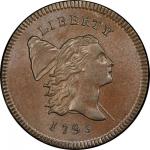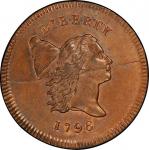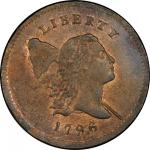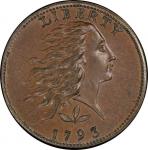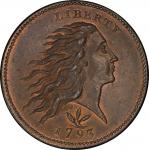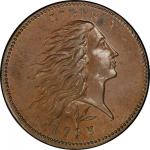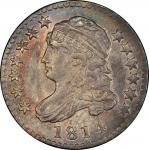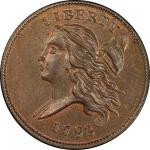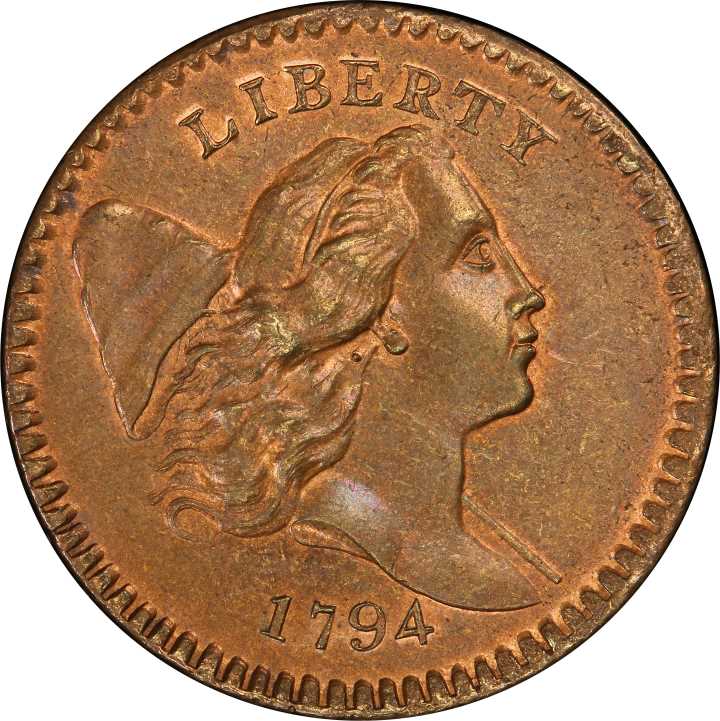1794美国无杆版自由帽半分 PCGS MS 67。“Habben ze Americanisha Gold Munzen?” — Fred Weinberg, 1977 This legendary coin, discovered less than 40 years ago, is widely acclaimed as the single finest half cent of its era. No other Liberty Cap half cent of any date, not even the much more common 1795 and 1797 issues, has survived looking as much like it did at the moment it was struck. This is unquestionably the ultimate specimen of this type, in terms of both the proportion of original color it retains and its certified grade. The appeal of this coin cannot be adequately captured by a number though, not even a lofty one. It likewise cannot be captured fully with even the best photography, but is best appreciated three-dimensionally and up close. Both sides show abundant original mint red color and an unparalleled lustrous sheen, the fields nearly prooflike with resounding cartwheel and reflective traces of bright color showing around some design elements. The high relief of Liberty’s portrait, distinctive enough to give this die variety its moniker, is remarkably sculptural. The high waves of Liberty’s hair often float above other tresses, with insufficient metal flow to give those deepest recesses of the die any hope of creating an impact. On this coin, subtle flat areas are seen on just the very highest peaks and ridges, while most hair details and the beautiful face of Liberty herself are crisply rendered. The reverse, surprisingly, is just as sharp, lacking no expected details among the devices or legends.
Some trivial planchet texture remains present in its usual area against the right obverse rim, where a couple of denticles also lack full definition, and a smaller area just inside the denticles in the southeast quadrant of the reverse. Aside from a single short scratch in front of Liberty’s lips, no other marks are noteworthy, even under a glass. The preservation is, in every sense of the word, incomparable. Used by Walter Breen to illustrate his die state I, this piece is high grade enough to display the very delicate lapping lines in the right obverse field, most notable near Liberty’s chin. The clash marks are not particularly prominent, with vestiges visible at the base of Liberty’s cap where it meets her hair, above her cap at the hair, and near the juncture of the pole and neck. On the reverse, the clash mark impression of Liberty’s bust truncation is very shallow atop the wreath, into the space between STATES and OF. A single solid crack is present from the rim through the right serifs of the top and bottom strokes of E in UNITED, continuing past two leaves to the wreath. A more delicate crack is disconnected from design elements in the area above the left top of U in UNITED to below the left ribbon end. A short horizontal crack is seen on the obverse at Liberty’s temple. This is later than Manley’s die state 1.0, though he refers to this coin as an exemplar, and is better placed as early within his die state 2.0. A tiny number of 18th century United States Mint copper coins have been given grades equal to this one, and two 1793 cents have been graded by PCGS at even higher levels. However, most experts who have studied all of these coins in hand would be hard-pressed to identify even a single half cent or cent that has been better preserved since the time of its mintage than this coin.
Among half cents, there is no contest; the only other PCGS MS-67 RB 18th century half cent is the D. Brent Pogue 1796 No Pole, making direct comparison simple. While that half cent was the first to ever cross the half million dollar barrier when sold in 1996, the presently-offered 1794 became the first million dollar half cent, carried to extraordinary heights by extraordinary quality. Breen’s Condition Census, composed primarily by Jon Hanson, identifies just two Uncirculated specimens of this die variety: this coin and the one in the British Museum. Though well struck and of apparent gem quality, the specimen from the 1818 Sarah Sophia Banks bequest to the British Museum is no longer “Mint red,” as described in the Breen half cent encyclopedia, but is an even dark brown with some suggestions of faded mint color. This variety is actually among the most elusive of the date and, when encountered at all, is apt to be found well circulated. Roger Cohen’s was graded VF-25 when sold in 1990 and was termed a “high grade 1794 Cohen-7.” The Manley plate coin, formerly in the Bob Yuell (Whister) Collection, was graded EF-40 when sold raw and variously listed as between fourth and sixth finest known of the variety. The coin’s modern history is both recent enough to still be cherished in its discoverer’s memory and distant enough to be the stuff of half cent legend.
In the spring of 1977, Fred Weinberg of Numismatics Ltd. was in Switzerland on a typical coin-buying mission, gathering up American gold coins of the sort that accreted in Swiss banks and shops in the mid 20th century. On this particular trip, he was invited to a small coin show by Swiss dealer Heiner Stuker. After traveling perhaps an hour from Zurich, Weinberg arrived at a dimly lit and perfectly round building housing a motley assemblage of small-time dealers, most of whom were closer to the hobbyist end of the continuum than its full-time professional opposite. Nearly all of the coins were offered on velvet trays resting upon tabletops. Weinberg circulated the room, volleying in his limited Schweizerdeutsch to each of the gathered vendors “Habben ze Americanisha Gold Munzen?”, the inquiry for “do you have any American gold coins?” [“haben Sie amerikanischen Goldmunzen?”] After buying some of the usual United States gold issues, the young American reached the table of an older couple in clothes more evocative of farming than numismatics. Their eyes lit up upon hearing the question, followed by a flurry of unintelligible Swiss German. Upon realizing Weinberg’s skill in their native tongue had been exhausted, the wife of the couple gestured to a valise, and the husband produced two American coins: a slightly worn key date 1916 Standing Liberty quarter and the presently offered half cent. After a momentary lapse of reason during which Weinberg considered and dismissed the possibility that what he was seeing was tantamount to a numismatic mirage, he pulled one more arrow from his linguistic quiver: “vass iss da price?” The coin was acquired for the Swiss francs equivalent of about $1,200.
Weinberg’s traveling companion, Heiner Stuker, later spoke to the couple and gathered that “the copper coin has been in this village for a long time, passed down from family,” as Weinberg recalled in 2013. This coin made its debut at the 1977 American Numismatic Association show and found a new home, with the assistance of Julian Leidman, shortly after the Central States Numismatic Society convention in early 1978. After apparently spending nearly two centuries in a Swiss village, it resided for more than three decades in the Missouri Cabinet collection of R. Tettenhorst. Its finder, upon seeing the coin again this year, confirmed that its appearance has not changed a bit since he first chanced upon it as a young man. In the 2014 Grading Guide for Early American Copper Coins, this piece is illustrated and described as “the only 18th century US half cent that has been graded MS-67 by EAC standards.” In its only auction appearance, it became the first half cent to ever sell for over one million dollars. PCGS# 35058. 1794 Liberty Cap Half Cent. Cohen-7. Rarity-5. High Relief Head. Mint State-67 RB (PCGS).


